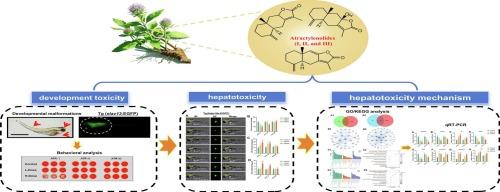Differential toxic phenotypes and liver injury induced by Atractylenolides (I, II, and III): Insights from zebrafish (Danio rerio) models and network toxicology
IF 4.3
3区 环境科学与生态学
Q2 BIOCHEMISTRY & MOLECULAR BIOLOGY
Comparative Biochemistry and Physiology C-toxicology & Pharmacology
Pub Date : 2025-09-23
DOI:10.1016/j.cbpc.2025.110365
引用次数: 0
Abstract
Atractylenolides (I, II, and III), active sesquiterpene lactones from Atractylodes macrocephala Koidz, exhibit diverse pharmacological activities but have been reported to impair drug-metabolizing enzymes and hepatocellular function. However, a comprehensive safety assessment of these compounds remains lacking. In this study, we investigated the developmental toxicity profile of Atractylenolides (I, II, and III) in zebrafish embryos, with a particular focus on hepatotoxicity and its underlying mechanisms. Exposure to Atractylenolides (I, II, and III) resulted in concentration-dependent mortality, with 96-h median lethal concentrations (LC₅₀) of 81.64 μM, 138.40 μM, and 151.90 μM, respectively. Atractylenolides (I, II) induced multiple developmental abnormalities, among which Atractylenolide-I uniquely led to neuronal developmental arrest and diminished locomotor activity. Importantly, Atractylenolides (I, II) exhibited marked hepatotoxicity, evidenced by liver shrinkage, reduced liver-specific fluorescence intensity, and elevated levels of aspartate aminotransferase (AST) and alanine aminotransferase (ALT). In contrast, exposure to Atractylenolide-III did not induce significant toxic effects. Network toxicology analysis revealed that cytochrome P450 (CYP450) metabolism and apoptosis were closely associated with Atractylenolides (I, II) induced hepatotoxicity. qRT-PCR analysis revealed that Atractylenolides (I, II) suppressed mRNA expression of key drug-metabolizing genes, including cyp3c1 and cyp3a65. Simultaneously, Atractylenolides (I, II) downregulated genes associated with cell proliferation (top2α, uhrf1). Co-treatment with the hepatoprotective agent silybin partially reversed the liver injury and the alterations in drug metabolism gene expression induced by Atractylenolides (I, II). Collectively, our results provide important insights into the safety evaluation of Atractylenolides (I, II, and III).

苍术内酯(I, II和III)诱导的不同毒性表型和肝损伤:来自斑马鱼(Danio rerio)模型和网络毒理学的见解
苍术内酯(I, II和III)是来自苍术的活性倍半萜内酯,具有多种药理活性,但有报道称会损害药物代谢酶和肝细胞功能。然而,对这些化合物的综合安全性评估仍然缺乏。在这项研究中,我们研究了白术内酯(I, II和III)在斑马鱼胚胎中的发育毒性,特别关注肝毒性及其潜在机制。暴露于苍术内酯(I, II和III)导致浓度依赖的死亡率,96小时的中位致死浓度(LC₅0)分别为81.64 μM, 138.40 μM和151.90 μM。苍术内酯(I, II)诱导多种发育异常,其中苍术内酯-I唯一导致神经元发育停滞和运动活动减少。重要的是,苍术内酯(I, II)表现出明显的肝毒性,肝脏萎缩,肝脏特异性荧光强度降低,天冬氨酸转氨酶(AST)和丙氨酸转氨酶(ALT)水平升高。相比之下,暴露于苍术内酯- iii没有引起明显的毒性作用。网络毒理学分析显示,细胞色素P450 (CYP450)代谢和凋亡与苍术内酯(I, II)引起的肝毒性密切相关。qRT-PCR分析显示,苍术内酯(I, II)抑制了关键药物代谢基因cyp3c1和cyp3a65的mRNA表达。同时,苍术内酯(I, II)下调与细胞增殖相关的基因(top2α, uhrf1)。与保肝剂水飞蓟宾共同治疗可部分逆转苍术内酯引起的肝损伤和药物代谢基因表达的改变(I, II)。总的来说,我们的结果为白术内酯(I, II和III)的安全性评估提供了重要的见解。
本文章由计算机程序翻译,如有差异,请以英文原文为准。
求助全文
约1分钟内获得全文
求助全文
来源期刊
CiteScore
7.50
自引率
5.10%
发文量
206
审稿时长
30 days
期刊介绍:
Part C: Toxicology and Pharmacology. This journal is concerned with chemical and drug action at different levels of organization, biotransformation of xenobiotics, mechanisms of toxicity, including reactive oxygen species and carcinogenesis, endocrine disruptors, natural products chemistry, and signal transduction with a molecular approach to these fields.

 求助内容:
求助内容: 应助结果提醒方式:
应助结果提醒方式:


